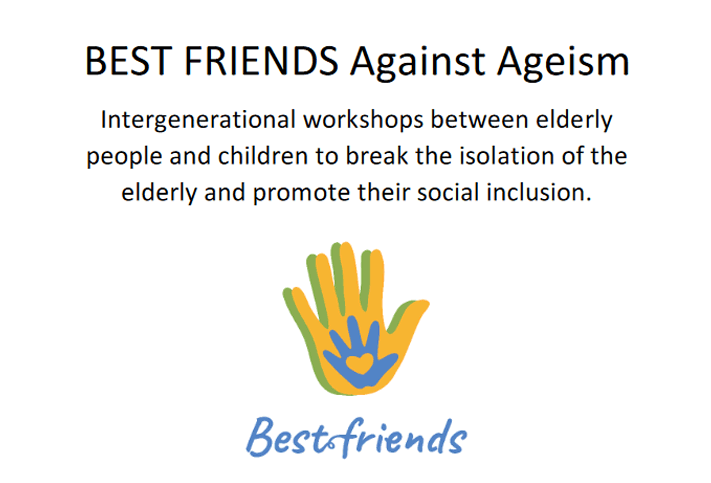
| Short descriptor of good practice |
| BEST FRIENDS against Ageism – Inter-generational workshops between old people and children to break the isolation of elderly people and support their social inclusion is a project that aims to address the isolation of elderly people by developing an innovative curriculum for social care workers/volunteers and games that promote inter-generational communication and learning. |
| Type of setting where good practice is delivered |
| Activities that were implemented in the frame of BEST FRIENDS project results: – Focus groups with elderly people, social care workers and social care volunteers – Records of Autobiographical Life Stories Videos – Collection of good practices to provide organizations with a method to enhance planning in the field of inter-generational learning and to raise awareness at the local and national level about inter-generational learning as an area of professional and social action – Staff training on approach, good practices and methodological concepts – Collection of tools for social care workers, volunteers, elderly people, educators All the activities can be implemented in any setting from NGOs, public institutions or adult education organizations. |
| Time Frame for delivery of good practice |
| Focus is on group learning. With essentials (https://bestfriendsproject.eu/media/best-friends-io2-en.pdf) that involves all steps for preparing and implementing learning process as well as reaching the outcomes, it’s relatively easy to organize the activities. After forming learning group, the focus then is just to start working with them.. |
| Type of learner the best practice is supporting |
| The target groups are care work practitioners, social workers and volunteers working with elderly people as well as seniors. |
| Resources used as part of good practice |
| Handbook – https://bestfriendsproject.eu/media/io2-bestfriends-piloting-overall-report-en.pdf Inter-generational Learning Training Program – https://bestfriendsproject.eu/media/best-friends-io2-en.pdf Autobiographical Life Stories Videos – https://www.youtube.com/channel/UCmwM7JV_NXmn65AC5jaUMhQ |
| Aims and objectives of good practice |
| – To provide an innovative method for social workers, volunteers, and educators working with elderly people – To break the isolation of elderly people through social participation and inclusion in EU communities – To improve the physical and mental health of older people through interaction with young children – To enrich the learning processes of elderly people through their interaction with young children – To promote inter-generational relationships, overcome stereotypes and enhance inter-generational solidarity against ageism through fun activities – To increase children’s self-confidence and sense of responsibility through respecting seniors |
| Evidence as to why this was considered good practice |
| This practice analyzed the existing methods and the current needs of social care workers, social workers, elderly people and secondarily educators. It gives an overview of the current state of art of the care situation of elderly people, especially about their social inclusion status in the community, good practices, pedagogical approaches, and of the training needs of social care workers and educators in terms of competences needed to use it in their work with elderly people. |
| 3 Key learning Principles that were used in this good practice to support senior learners |
| 1. Inter-generational learning 2. Experiential learning 3. Holistic approach to well-being |
| Any additional learning that we can take from this good practice example |
| In Latvia, municipalities such as Gulbene (this good practice) play an important role in implementing social inclusion policies including the provision of social services and social assistance corresponding to the needs of the residents. |
| Any Additional Information |
| / |
